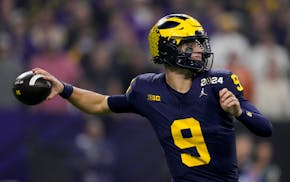Every major league sport honors its history. Even casual sports fans are aware of legendary performances such as Wilt Chamberlain scoring 100 points in a basketball game, Cal Ripken's consecutive-games-played record in baseball, or the Vikings' 0-for-Super Bowl record.
Acknowledging cycling as a niche sport with a small audience even in its best years, most American fans of the Tour de France focus on the now discredited achievements of Lance Armstrong.
A new book by Daniel de Visé, "The Comeback: Greg LeMond, the True King of American Cycling, and a Legendary Tour de France," sets the record straight. With Armstrong's victories invalidated, LeMond is the only American to capture the Tour de France, winning in 1986, 1989 and 1990.
Overall, De Visé adds some new details, but much of this history has been covered extensively in a long shelf of LeMond- and Tour de France-related books. For informed readers, De Visé's exploration of Kathy LeMond's role in her husband's success is worth the purchase price. Kathy LeMond, who was born and raised in West Salem, Wis., near La Crosse, broke with Tour tradition by traveling stage-to-stage with her husband and his teams. Her contributions to his salary negotiations, relationships with team managers and sponsors, and opinions about doping played an important and overlooked role in LeMond's arc.
LeMond's story is filled with tales of overcoming personal adversity, tangled professional relationships and record-setting victories. The new book documents LeMond's significant contributions to the sport, maybe underestimated by casual racing fans. His performances changed the salary structure of professional bicycle racers, and adoption of cutting edge technologies led to the closest victory in Tour de France history. LeMond's use of a solid disk wheel, aerodynamic helmet and a handlebar design borrowed from professional triathletes played critical roles in the eight-second victory in 1989. It was a record at the time. LeMond's highly visible questioning of drug use in pro cycling caused controversy and damaged his standing.
Early chapters of the book recap LeMond's childhood in California and the dawn of his amateur bicycle racing career while he was a teen. After a series of impressive victories, France legend Bernard Hinault recruited LeMond to join the elite Renault-Elf-Gitane pro bicycle racing team.
In 1986, a year after helping Hinault win his fifth Tour de France, LeMond became the first American to win it. He was 25.
Other books have profiled LeMond's achievements, but "Comeback" offers more depth. In the widely reported 1987 turkey hunting accident that left LeMond's body riddled with more than 100 lead pellets, De Visé describes how LeMond lost almost half of his blood volume and a California Highway Patrol helicopter responding to a nearby traffic accident was diverted to transport LeMond to a hospital. It looked like serendipity. Without the availability of the helicopter, LeMond's blood loss may have killed him.
The author's minute-by-minute description of the final stage of the 1989 Tour also add layers of understanding for cycling fans. Previous authors often described the 1989 Tour with the focus on LeMond's "comeback." De Visé alternates chapters, adding context and perspective from Laurent Fignon, LeMond's main competitor and France's past winner. Peering into the mind-set of both camps gives the book intrigue and suspense.
At the start of the final stage of the 1989 Tour, LeMond trailed Fignon by 50 seconds. Fignon felt the Tour's famed yellow jersey was his to keep.
Yet, in a first for the Tour, the last stage was an individual 24 ½-kilometer time trial. Using an aerodynamic helmet and specially designed aero handlebars adopted by triathletes, LeMond's position on the bike allowed him to pedal efficiently and remain in a tight, streamlined position. At the finish, LeMond had set the record for the fastest time trial in a Tour. When Fignon left the starting ramp, race officials, racers and fans crowded around clocks tracking Fignon's progress along the course. Near the end of the course, stunned fans realized Fignon would not match his rival's performance. LeMond's eight-second margin of victory at the 1989 Tour de France remains the closest race in history.
LeMond captured his third Tour de France victory a year later. Despite high expectations to match and possible exceed the wins of Tour legends like Hinault, LeMond never returned to the Tour podium. He struggled with fatigue, later diagnosed as mitochondrial myopathy. At the same time, rampant drug use among professional cyclists altered the competitive landscape. Riders who disdained drugs simply couldn't keep up.
LeMond turned his attention to building cycling brands to build his legacy.
After some early missteps, LeMond's work with Trek Bicycles seemed to put him on a long-term road to success.
As doping suspicions enveloped Armstrong, LeMond was one of the few professional cyclists to openly question Armstrong's performances. The controversy led to lawsuits, countersuits and Trek's controversial discontinuation of the LeMond bike brand.
In the aftermath of Armstrong's admission of using performance-enhancing drugs, cycling fans have revisited LeMond's place in the sport. A 1984 New York Times article called LeMond "almost certainly the greatest bicycle racer in American history." De Visé adequately tells the story of that journey. For casual cycling enthusiasts learning the deeper story of LeMond, "Comeback" is a good foundation. For more knowledgeable readers, De Vise's exploration of Kathy LeMond and her influence takes readers down new roads.
Lou Dzierzak is a freelance writer from Richfield.
2024 NFL Draft: List of first round picks
Frankie Capan III shoots 13-under 58 in Korn Ferry Tour event at Texas Rangers Golf Club

